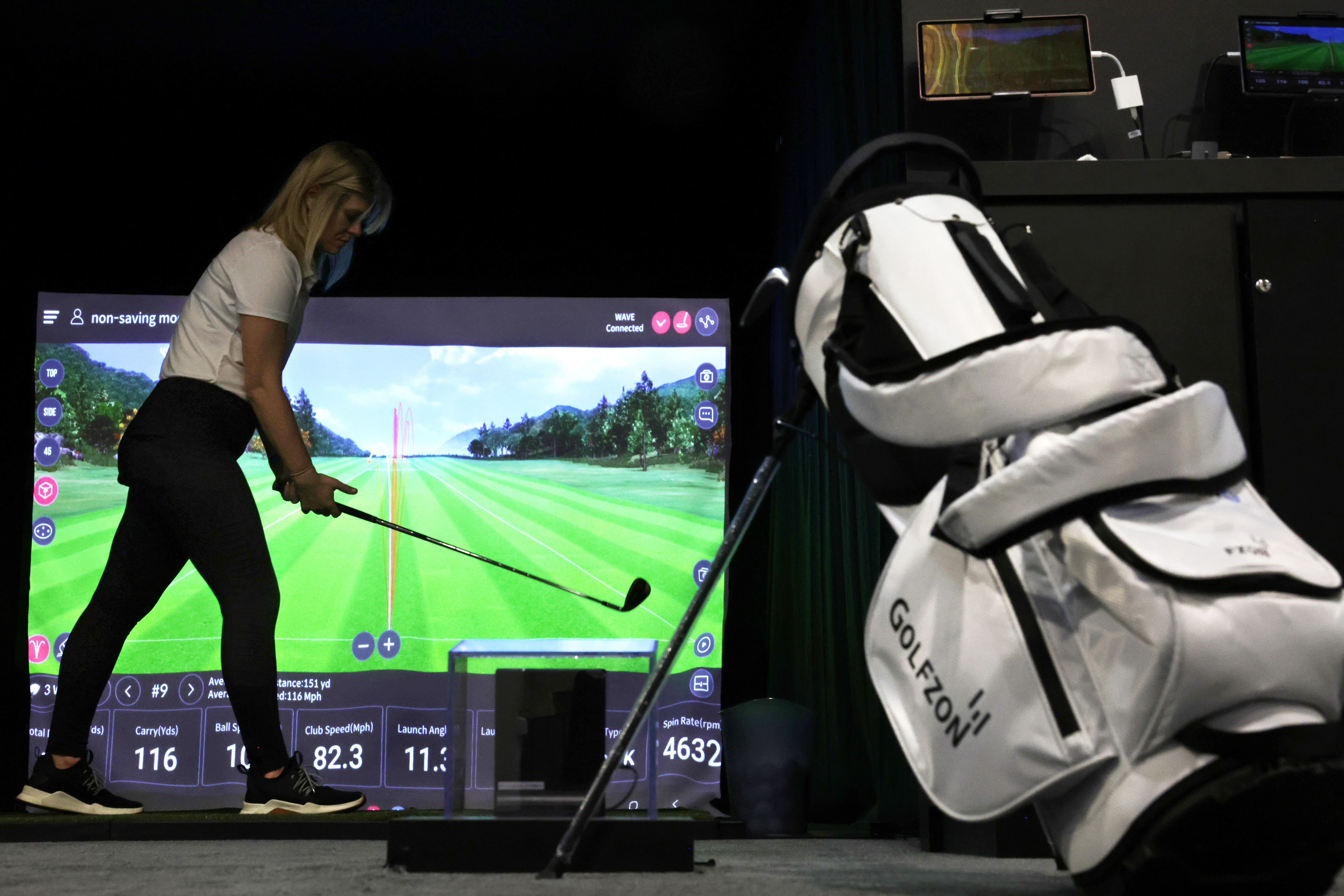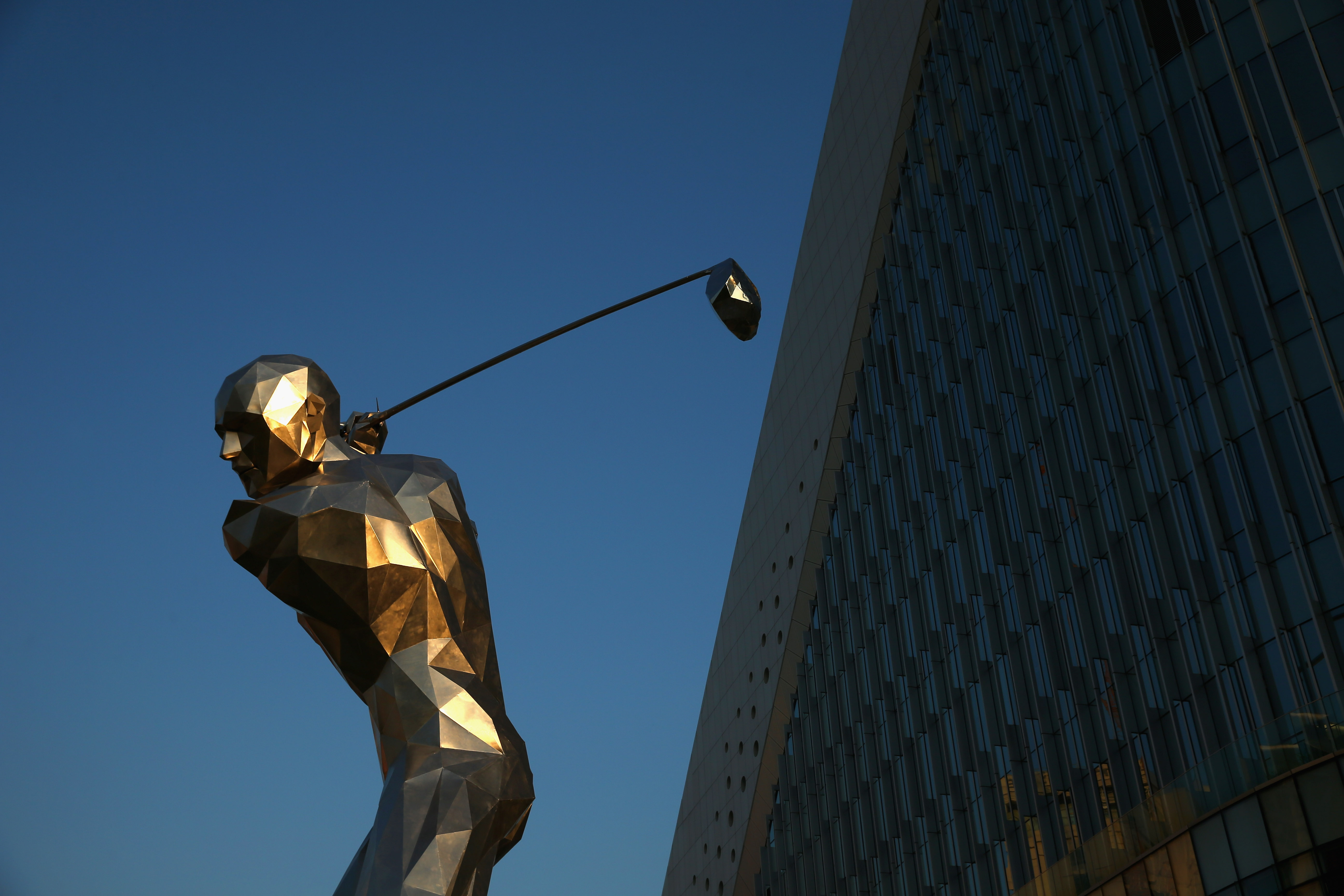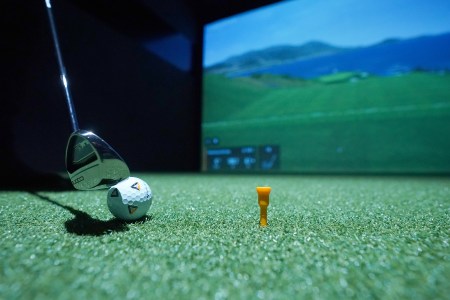From the tee, I threw a bit of caution to the wind and blasted a nearly perfect draw with my driver around the trees and into the fairway on the par-4 third hole at Pebble Beach.
Normally, I would have just aimed a hybrid at the bunker on the right for a safe shot and a short iron into the green. But after double-bogeying the first two holes, I needed to let a bit of low-key rage out of my system. Thankfully the gamble paid off and I was left with a flip wedge into a front pin. But as I got ready to hit the shot, I felt the ground beneath my feet begin to shift.
It wasn’t an earthquake. At least not a literal one you’d feel from San Andreas tectonic friction. But motors and hydraulics were repositioning the floor I was standing on to simulate the lie I’d have if I were actually in California — and not on the other side of the country, in a mall in West Nyack, New York.

Greetings from Golfzon
But that’s part of the technology that makes Golfzon’s TwoVision simulator system rather special. The brand uses a 24-way directional moving plate that shifts to mimic stance and lie conditions in correspondence with actual topographical features on the course. The hitting mats also offer five different surfaces to imitate fairway, light rough, long grass, firm fairway bunkers and the softer green side varieties.
I played the first two holes from relatively flat spots in the fairway, so the movement of the plate was less perceptible. Both approach shots landed in green side bunkers. The sand shots weren’t particularly tricky…but the greens, on the other hand, were a serious test.
Golfzon’s TwoVision has cracked the code and leveled up the difficulty in simulator putting. Playing on other sims, a two-putt is almost automatic, as the sensors aren’t accurate enough to register variations in ball speed off the putter face. Golfzon’s tech reads path and pace with stunning precision right at impact. The simulator’s computer caddy gives players highly accurate reads and an aim point via a projected LED display on the floor. But players must judge the weight of the putt just right to get a putt to drop or even leave a gimme inside the leather — no easy task.
How to Use a Golf Simulator to Improve Your Game
The indoor golf revolution is here to stay. Let’s make the most of it.No More Two-Putts
By the time I got to the par-5 sixth hole, my personal favorite on the course, Golfzon’s regional manager Ben Mackey asked me why I had picked Pebble. I told him it was because I’ve played the course half a dozen or so times in real life and scores of times on other sims. He then said, “Ah! Just asking because these are the toughest greens we have.”
He wasn’t kidding; I think I three-putted (or worse) nine times. For my second round, I picked the Old Course, where the putting surfaces weren’t quite as caustic and I finished with a score 10 shots lower than my first go.
Here at the Palisades Center, the twelfth-largest mall in America, Golfzon Social offers players 22 TwoVision simulator bays along with a full bar, a pub-style food menu and flat screen televisions in every direction. It’s a fun and engaging way to experience indoor golf even on a low key Monday morning. Steven Schenck, assistant GM for Golfzon Social’s Palisades location, says things get much more raucous as the weekend nears: “There will be howling over shots and the atmosphere gets a little electric.”
For anyone who has been to a TopGolf, it’s not hard to imagine the scene. But unlike the ragingly popular gamified driving range, Golfzon lets you actually play golf, shape shots (like I did back on the third at Pebble) and putt. So it’s more akin to actual golf and for my money, more satisfying.
South Korea’s Starbucks?
It’s a formula that proved successful in Golfzon’s native South Korea, where the company boasts more than 8,974 locations. For reference, the seemingly ubiquitous Starbucks has around 6,500 licensed coffee shops in the United States.
Today, the company, which is also Korea’s largest golf retailer, has 120 locations open for business in the USA, and Golfzon America CEO Tommy Lin says the company sees the market as a place where indoor golf has a real shot of catching fire. “The golf simulator-entertainment business has been growing for four to five years,” he says. “So, we are working hard to make our product more relevant to US golfers in terms of customer service and capabilities to deliver the high expectations of our customers.”

Pace of Play
There’s a lot to love about simulator golf, but perhaps most beguiling is how it mitigates one of the biggest barriers to playing a round — the onerous time commitment. A speedy 18 holes played on grass takes about four hours, not counting a warm-up on the range or commute to and from the course. During my visit to Golfzon Social, I played 54 holes, had a tasty Mexican street corn dip, a cup of coffee and a few conversations, all in about two and a half hours.
As much as I love traditional golf, a sim round doesn’t require searching for balls or even having to travel between shots. A player can whip through 18 holes in 30-40 minutes. Of course they aren’t getting the exercise they would normally, but a quick golfer could leave their desk at work, play 18 and still have time to grab a burrito during an hour lunch break.
Simulator golf is also less formal, which is a great way to introduce new players to the game. It’s a friendly environment without the usual country club dress code. Plus there is no group playing in front or behind. “I still remember standing on the first tee, so nervous with people behind me,” says Lim of his introduction to golf. “You feel them watching, but in the simulator, you don’t have to worry about that. There’s no one behind you waiting to hit their shot.”
For beginners, or any golfer keen on improvement, the TwoVision sims offer one of my favorite features — video of every shot. Players can watch the swing they just made to spot and ameliorate breakdowns or reinforce the bits and bobs that are working: from back swing, to impact and follow through. Of course, using a simulator with cameras as a learning or teaching tool offers obvious benefits. So in 2018, Golfzon acquired the David Leadbetter Academy…now known as Golfzon Leadbetter Academy, with more than 25 locations worldwide.
The Future of Sim
Beyond the recreational game and instruction utility, professional golf is embracing sim tech to create new series for fans. Tiger Woods and Rory McIlroy launched a new league called TGL with six teams competing on extra large screens but playing off real grass and sand to rotating green complexes. The league was set to debut this January but has been delayed until 2025 due to damage to the arena in Palm Beach that was set to host the series.
Some, myself included, are skeptical the league will draw enough interest to make it sustainable. But there’s a good bit of financial backing behind it and a successful blueprint from…you guessed it, Korea, where Golfzon’s G-TOUR has been thriving since 2013.
Reigning G-TOUR champion Hongtaek Kim says screen golf competition has become intense. “The prize money is no joke, rivaling a second-tier tour,” Kim says. “Pros are putting in serious practice hours, treating it like a high-stakes showdown to flaunt their skills.”
Kim, who won 11 times last season on the G-TOUR and won once on the KPGA Tour, says the Korean audience embraces the up-close and personal vibe, quick game sessions and the sense of familiarity that has evolved over time.
Will it translate for a US audience? Kim isn’t quite sure, but he’s definitely sitting on the optimistic side of the fence. “It’s a bit tricky to predict,” he says. “But considering the accuracy, game speed and accessibility that screen golf brings, it’s got the potential to be a massive hit in the U.S.!”
Of course simulator golf isn’t a replacement for traditional golf. It’s just another way to play and enjoy the game. “Both are a must for me,” Kim says. “The love for golf is real, and I bet both the indoor and outdoor scenes will keep thriving. It’s the best to play both worlds.”
The Charge will help you move better, think clearer and stay in the game longer. Subscribe to our wellness newsletter today.






















